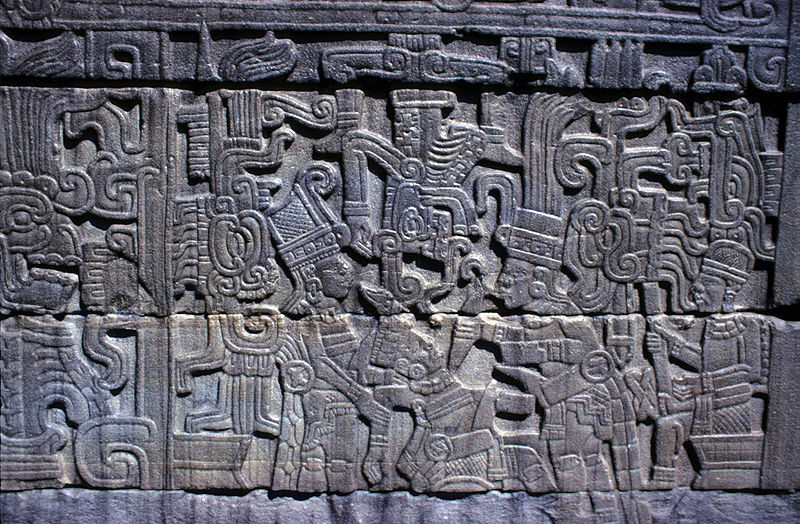The return of Mayan-style human sacrifice June 25, 2010
Author: Beach Combing | in : Medieval , trackback
Beachcombing loves the way that some of the best historical stories hide behind the most oblique academic titles. Take, for example, Vera Tiesler and Andrea Cucina, ‘Procedures in Human Heart Extraction and Ritual Meaning: A Taphonomic Assessment of Anthropogenic Marks in Classic Maya Skeletons’ (Latin American Antiquity 17 2006).
Andrea and Vera really pull out all the stops here. Most non-specialist readers will just about make it to the colon, perhaps with an image of a Maya in a surgical gown. But then they will then get hit by the double-whammy of ‘taphonomic’ and ‘anthropogenic’ and decide to read the newspaper instead.
This would be a mistake.
After all, the Maya and other Mesoamerican peoples sacrificed human beings to their gods. It has also long been known that, of the many methods of sacrifice that were practised, one of the most important (though perhaps not one of the most common) was the removal of the still beating heart from a sacrificial victim – don’t be misled by Vera and Andrea’s innocent-sounding ‘heart extraction’. Anyone who was unfortunate enough to have watched Indiana Jones and the Temple of Doom in their formative years will know exactly what Beachcombing is talking about. For the rest of his readers he has appended a useful illustration at the head of the blog.
However, to date no unambiguous skeletal proof has been found. Cue an interesting phenomenon that Beachcombing has noticed with archaeologists dealing with human sacrifice elsewhere in the world: partial or complete denial. Indeed, as in some examples of Iron Age Germanic and Celtic ‘live’ burials, not to mention the Carthaginian child sacrifices of antiquity, archaeologists began to question whether sacrifice wasn’t all a big ‘cultural misunderstanding’ made up ‘by hostile neighbours’ or ‘modern sensationalists’. Archaeologists at root are sentimentalists.
Well, Vera and Andrea decided to have a second look at the skeletal evidence and see if ‘heart extraction’ could really be so easily discarded. To do this they got close and personal with five suspicious-looking Maya skeletons from 600-900 AD. What a shame though that they didn’t also have a real sacrificial victim to test their hypotheses on! But of course that wouldn’t be possible… Would it? Over to you girls.
‘To evaluate procedures that could have produced the lesions described here, and to gain further insights, three approaches to the heart were replicated by [names of personnel excluded by Beachcombing to prevent google-induced blushes] of the Medical Forensic Service in Mérida (Yucatán) on modern cadavers. Bifacial obsidian knives were used for horizontal and parasternal transthoracic accesses and a subthoracic transdiaphragmatic access [figures given] following the specific indications provided by the authors. The bodies were laid down in an overextended position to replicate the iconographic representations. Tests were also performed to distinguish whether liver and other internal organs’ disembowelment could have taken place instead of heart removal and where potential marks would have been left on the skeleton.’
Briefly, then, members of the staff of the Medical Forensic Service in Mérida (Mexico) took three corpses. The staff pinioned the corpses out on the table in the style of illustrations of Mayan sacrifices (‘overextended position’). They then proceeded to remove the heart from the three corpses, following a different technique on each body, employing Mayan cutting instruments (‘bifacial obsidian knives’) instead of scalpels. They also removed the liver and other organs. All this was done to see whether marks were left on the skeleton.
And boiled down even further… C. 2006, for the first time in perhaps half a millennium, Mayan sacrifices were carried out in Mérida.
Now, make no mistake, the experiment worked. Vera and Andrea were able to show that the skeletons that they had studied had very likely had their heart removed in a sacrificial ceremony. They were also able to reconstruct the technique used to remove the heart: it transpires a short and painful one with priests holding the victim in place.
But happy as he is with any advance in knowledge, Beachcombing’s first thoughts were, he must confess, for the cadavers. Had the mortuary some John Does to hand? (Next time Beachcombing is in Mexico he’ll tattoo his wife’s cell phone number on his chest in case of unexpected death.) Or were locals good enough to give their corpses to history instead of to science?
Give your body to history…
Beachcombing doesn’t like the sound of this but he can see the possibilities.
‘How long would a fifteenth century heretic have taken to burn? With your husband’s kind donation, Ma’am, we’ll soon know.’
‘Thank-you, your grandmother has pushed back the boundaries of prehistory by allowing us to sink her naked body into an Irish bog while archaeology students hummed a druid tune’.
‘Medieval light cavalry? No, I can’t have this. The cadaver experiments of 2011 showed conclusively how much damage galloping horses can do to unarmoured infantry.’ etc etc etc
Personally, Beachcombing is hanging on to his transplant card.
Beachcombing would love to have any thoughts on this [drbeachcombingATyahooDOTcom] and he hopes, at a future date, to visit the fascinating question of Mayan basketball and attendant human sacrifice



